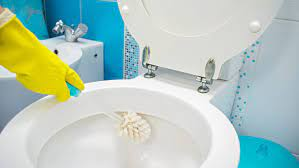In TV ads for bathroom cleaners you will often see germs portrayed as nasty little creatures with sharp teeth. While you may not encounter anything as frightening, your bathroom is full of germs. They seem to gather daily and can make one sick if they aren’t regularly combated. It is impossible to live in a bubble without germs. In fact, the majority of germs are on our body. Most are harmless, but let’s look at the ones that can cause problems in our bathrooms.

On your toilet seat, you can find the same gastrointestinal viruses which cause stomach upsets and even the infamous Norovirus. The gastrointestinal virus can be easily spread and remain on a surface for up to a week.
Pathogens are also spread by contaminated food. This includes E. coli and Salmonella. E. coli can cause severe diarrhoea and bloody stools.
Walking barefooted in the bathroom can transmit dermatophytid fungal infections, including athlete’s feet. Mould and mildew are also fungi that can be found in showers. While they do not cause infection, they may aggravate asthma and allergies.
If you keep your bathroom clean and maintain basic hygiene, the risk of getting sick from germs is very low. A tiny fraction of germs can cause illness.

Follow a few simple guidelines to avoid spreading anything unsavoury:
- For items that are difficult to clean, choose alternatives like shutters instead of curtains. For Shutters Gloucester, go to com/shutters/gloucester/
- Weekly, clean all surfaces and floors in the bathroom with a disinfectant cleaner. Once a month, a deep clean is recommended. You may want to do a deeper clean if you or someone in your family has the flu or a stomach bug.
- When tackling bathroom bacteria, use the right cleaner. Preferably one that contains bleach.
- Once a week, pay special attention to the bowl of the toilet and scrub it with soap and disinfectant. Bleach should be allowed to sit on the toilet bowl and the seat for at least 10 minutes, before washing with soapy water.
- Shower walls and floors should be kept free from mould and mildew.
- Keep a bottle of bleach or a package of cleaning wipes in each bathroom to clean bathroom germs.
- Reusing bathroom sponges can cause them to harbour bacteria and make surfaces even more contaminated than before.
- After using the toilet, wash your hands thoroughly before brushing your teeth.
- Close the lid of the toilet when flushing. Flushing aerosolises the microbes in the bowl. There are 3.2 millions per square inch. Yuck!
By following these steps, you can be fairly sure that you will not get infected by bathroom germs. Most germs are harmless and useful, as they help maintain our health and immune system.
